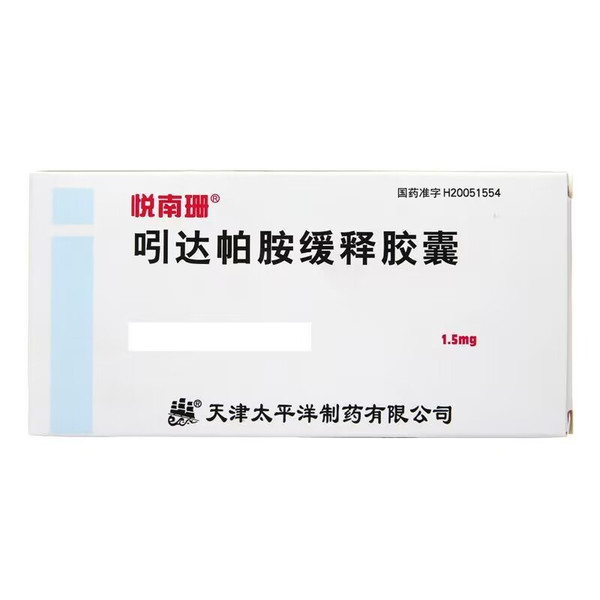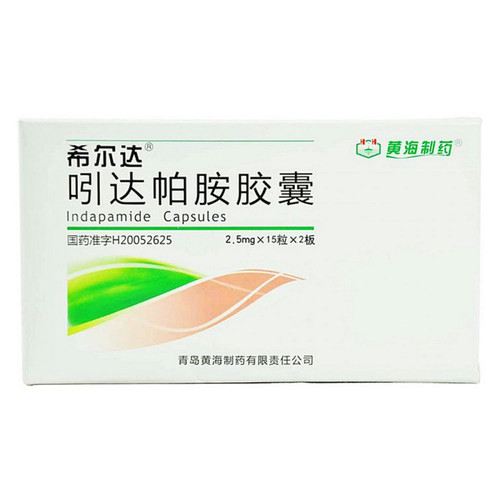Product Overview
[Drug Name]
Generic Name: Indapamide Sustained Release Capsules
Trade Name: Yue Nan Shan
English Name: Indapamide Sustained Release Capsules
Chinese Pinyin: Yindapa’an Huanshi Jiaonang
[Ingredients]
Main ingredient: Indapamide
[Properties]
This product is a hard capsule containing white or off-white spherical pellets.
[Indications]
Antihypertensive drug, used for essential hypertension.
[Dosage and Administration]
Oral. Once daily, 1.5 mg (1 capsule) or as directed by a physician, taken after breakfast.
[Adverse Reactions]
Mild nausea and dizziness may occur occasionally.
[Contraindications]
Contraindicated in patients with severe hepatic or renal impairment, recent cerebrovascular accident, use of thiazide diuretics, or allergies to similar drugs. Use with caution in pregnant women.
[Precautions]
With long-term use, attention should be paid to electrolyte imbalances and regular blood potassium checks should be performed.
[Use in Special Populations]
Precautions for Pediatric Patients:
There are no studies on the use of this drug in pediatric patients.
Precautions for Pregnancy and Lactation:
Use with caution in pregnant women.
Precautions for Elderly Patients:
Elderly patients are more sensitive to antihypertensive effects and electrolyte changes and require careful monitoring when using this drug.
[Drug Interactions]
1. Association with Antihypertensive Effects: When this drug is used in combination with other antihypertensive drugs, the dosage should be reduced, at least at the beginning. 2. Inappropriate Concomitant Use: · Lithium on a sodium-free diet (reduced urinary lithium excretion). Indapamide increases blood lithium concentrations and can lead to manifestations of lithium overdose. However, if a diuretic is used concomitantly, blood lithium levels should be carefully monitored and the dosage adjusted. · Non-antiarrhythmic drugs that cause torsades de pointes (including astemizole, bepridil, intravenous erythromycin, halofantrine, pentamidine, sultopride, terfenadine, and vincamine). Torsades de pointes (predisposing factors include hypokalemia, blood pressure, bradycardia, and QT prolongation). If hypokalemia occurs, do not use medications that can trigger torsades de pointes. 3. Concomitant medications requiring caution: · Nonsteroidal anti-inflammatory drugs (systemic), high-dose sodium salicylate: May reduce the antihypertensive effect of indapamide. In dehydrated patients, acute renal failure (decreased glomerular filtration) may occur. Rehydrate the patient, and monitor renal function from the start of treatment. · Other compounds that lower serum potassium: amphotericin B (intravenous), glucocorticoids and mineralocorticoids (systemic), tecocorticoids, stimulant laxatives; increase the risk of hypokalemia (synergistic effect). Monitor serum potassium and correct as necessary. Exercise particular caution when using digitalis. Use non-stimulant laxatives. · Baclofen: Potentiates the hypotensive effect. Rehydrate the patient; monitor renal function at the start of treatment. · Digitalis: Hypokalemia predisposes to the toxic effects of digitalis. Care should be taken to monitor serum potassium and electrocardiogram, and readjust treatment if necessary. Potassium-sparing diuretics (amiloride, spironolactone, triamterene): This combination of medication is beneficial for some patients, but the possibility of hypokalemia or hyperkalemia cannot be ruled out, especially for patients with renal failure and diabetes, who are more prone to hyperkalemia. Monitor serum potassium and electrocardiogram when necessary, and readjust treatment if necessary. Angiotensin-converting enzyme (ACE) inhibitors: In the presence of pre-existing sodium deficiency (especially in renal artery stenosis), the combination of indapamide and ACE inhibitors carries the risk of causing sudden hypotension and/or acute renal failure. In patients with essential hypertension, previous diuretic treatment may lead to sodium deficiency, and it is important to note: (1) Stop diuretics for 3 days before using ACE inhibitors; potassium-sparing diuretics can be restarted if necessary. (2) Or when giving ACE inhibitors, use a low starting dose and gradually increase the dose. In patients with congestive heart failure, the initial dose of angiotensin-converting enzyme inhibitors should be low and can be started after reducing the dose of hypokalemic diuretics. For all patients taking angiotensin-converting enzyme inhibitors, renal function (serum creatinine) should be monitored during the first week. Antiarrhythmic drugs that cause torsades de pointes: Class Ia antiarrhythmic drugs (quinidine, dihydroquinidine, disopyramide), amiodarone, bretylamide, sotalol: Torsades de pointes (hypokalemia, bradycardia, and preexisting QT prolongation are precipitating factors). Prevent hypokalemia and correct it if necessary; monitor the QT interval. During torsades de pointes, do not use antiarrhythmic drugs (pacemaker therapy is used instead). Metformin: Diuretic-induced functional renal insufficiency (particularly loop diuretics) can precipitate metformin-induced lactic acidosis. Do not use metformin if the serum creatinine level exceeds 15 mg/L (135 μmol/L) in men and 12 mg/L (110 μmol/L) in women. Iodinated contrast media: In the setting of diuretic-induced dehydration, iodinated contrast media increase the risk of acute renal failure, especially when used in high doses. Fluid repletion is essential before administering iodinated compounds. 4. Consider the following when using concomitant medications: Imipramine antidepressants (tricyclic antidepressants) and neuroleptics: Potentiation of antihypertensive effects and increased risk of orthostatic hypotension (synergistic effects). Calcium salts: Reduced urinary calcium excretion, leading to the risk of hypercalcemia. Cyclosporine: Risk of elevated serum creatinine when ACE inhibitors are used without increasing circulating cyclosporine levels, even in the absence of water/sodium depletion. Corticosteroids and teicosin (systemic): Reduced antihypertensive efficacy of indapamide (due to water/sodium retention caused by corticosteroids).
[Pharmacological Actions]
Animal studies have demonstrated antihypertensive and diuretic effects in experimentally hypertensive animals. This effect is dose-dependent: low doses exhibit a hypotensive effect, while high doses exhibit a diuretic effect. Its hypotensive mechanism may be through its effects on the arteriolar wall, reducing vascular tone and vascular responsiveness to pressor substances, thereby reducing peripheral vascular resistance; a diuretic effect may also be involved. Within the therapeutic dose range, in addition to its hypotensive and diuretic effects, it has no significant effects on the nervous, respiratory, digestive, or hematological systems. Acute and chronic toxicity studies on various animal models have demonstrated low toxicity.
[Storage] Store in a sealed container away from light.
[Specification] 1.5mg x 30 tablets
[Packaging Size] Box
[Expiry Date] 24 months
[Approval Number] National Medicine Standard H20051554
[Manufacturer] Company Name: Tianjin Pacific Pharmaceutical Co., Ltd.






